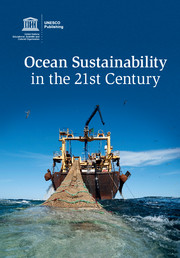Book contents
- Frontmatter
- Contents
- List of contributors
- Acronyms and abbreviations
- Foreword by Irina Bokova, Director-General of UNESCO
- Foreword by Thomas E. Lovejoy
- Preface
- Acknowledgements
- 1 Issues regarding oceans and opportunities: an introduction to the book
- 2 Main human uses of ocean areas and resources, impacts, and multiple scales of governance
- 3 Physical and chemical changes in the ocean over basin-wide zones and decadal or longer time-scales: perspectives on current and future conditions
- 4 Knowledge and implications of global change in the oceans for biology, ecology, and ecosystem services
- 5 A new perspective on changing Arctic marine ecosystems: panarchy adaptive cycles in pan-Arctic spatial and temporal scales
- 6 Ecosystem approach and ocean management
- 7 Challenges in using valuation in ecosystem-based management in a marine context: the case of UK Marine Protected Area designation
- 8 The contribution of international scientific cooperation and related institutions to effective governance for the oceans: the cases of regional tsunami early warning systems and the Argo project
- 9 Emerging and unresolved issues: the example of marine genetic resources of areas beyond national jurisdiction
- 10 The assumption that the United Nations Convention on the Law of the Sea is the legal framework for all activities taking place in the sea
- 11 The legal regime of outer space in light of the Law of the Sea
- 12 Towards sustainable oceans in the 21st century
- Index
- References
9 - Emerging and unresolved issues: the example of marine genetic resources of areas beyond national jurisdiction
Published online by Cambridge University Press: 05 May 2015
- Frontmatter
- Contents
- List of contributors
- Acronyms and abbreviations
- Foreword by Irina Bokova, Director-General of UNESCO
- Foreword by Thomas E. Lovejoy
- Preface
- Acknowledgements
- 1 Issues regarding oceans and opportunities: an introduction to the book
- 2 Main human uses of ocean areas and resources, impacts, and multiple scales of governance
- 3 Physical and chemical changes in the ocean over basin-wide zones and decadal or longer time-scales: perspectives on current and future conditions
- 4 Knowledge and implications of global change in the oceans for biology, ecology, and ecosystem services
- 5 A new perspective on changing Arctic marine ecosystems: panarchy adaptive cycles in pan-Arctic spatial and temporal scales
- 6 Ecosystem approach and ocean management
- 7 Challenges in using valuation in ecosystem-based management in a marine context: the case of UK Marine Protected Area designation
- 8 The contribution of international scientific cooperation and related institutions to effective governance for the oceans: the cases of regional tsunami early warning systems and the Argo project
- 9 Emerging and unresolved issues: the example of marine genetic resources of areas beyond national jurisdiction
- 10 The assumption that the United Nations Convention on the Law of the Sea is the legal framework for all activities taking place in the sea
- 11 The legal regime of outer space in light of the Law of the Sea
- 12 Towards sustainable oceans in the 21st century
- Index
- References
Summary
9.1 Introduction
While much of the ocean still remains to be explored, it is now known that it is extremely rich in biological diversity, including organisms which are host to unique genetic resources.
While the exact number of marine species is unknown, scientists estimate that there may be 0.7 to 1.0 million marine species, of which approximately 226,000 eukaryotic species have been described (Appeltans et al., 2012). More species were described in the past decade (c.20,000) than in any previous decade. It has been reported that there are approximately 170,000 synonyms; that 58,000–72,000 species are collected but not yet described; and that 482,000–741,000 more species have yet to be sampled. Molecular methods may add tens of thousands of cryptic species. Thus, there may be 0.7–1.0 million marine species. Past rates of description of new species indicate that there may be 0.5 ± 0.2 million marine species. On average, 37% (median 31%) of species in over one hundred recent field studies around the world might be new to science.
Thus, a very large proportion of marine species are yet to be discovered. It is thought that these species live in remote and hard-to-reach environments, such as the deep sea and the seabed, or are microscopic. In fact, the Census of Marine Life estimated that more than a billion types of microbes might live in the oceans (Census of Marine Life, 2010). One drop of seawater may contain as many as 350,000 bacteria and other microorganisms (Knowlton, 2010).
Article 2 of the Convention on Biological Diversity (CBD) defines genetic resources as genetic material of actual or potential value. Genetic material is defined as any material of plant, animal, microbial, or other origin containing functional units of heredity. It follows that marine genetic resources are material from marine plants, animals, and microbial or other organisms, and parts thereof containing functional units of heredity of actual or potential value.
- Type
- Chapter
- Information
- Ocean Sustainability in the 21st Century , pp. 198 - 231Publisher: Cambridge University PressPrint publication year: 2015
References
- 1
- Cited by



